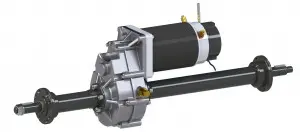How Can Electric Transaxles Improve Fuel Efficiency?
Introduction
In the rapidly evolving automotive industry, the shift towards electric vehicles (EVs) has gained significant momentum. Central to this transition is the electric transaxle, an innovative component that combines the electric motor, transmission, and differential into a single unit。This integration not only enhances the overall efficiency of the vehicle but also contributes significantly to fuel efficiency, making electric transaxles a cornerstone of modern sustainable automotive technology。
Understanding Electric Transaxles
Definition and Basic Function
Electric transaxles are integral to the propulsion systems of electric and hybrid vehicles. Unlike traditional transaxles that rely on internal combustion engines, electric transaxles draw power from an electric motor. This motor’s torque is transferred to the wheels via the transaxle, facilitating efficient and responsive vehicle operation。
Key Components
The primary components of an electric transaxle include the electric motor, the differential, and the gearbox. Each component plays a crucial role in the vehicle’s performance:
Electric Motor: Provides the power needed to propel the vehicle.
Gearbox: Adjusts the speed and torque to match driving conditions.
Differential: Ensures the wheels can rotate at different speeds during turns, enhancing stability。
Mechanisms for Improving Fuel Efficiency
Direct Energy Transfer
One of the most significant advantages of electric transaxles is their ability to transfer energy directly from the electric motor to the wheels. This direct connection minimizes energy loss, which is common in traditional mechanical systems with multiple components. Electric motors can convert over 90% of the energy from the battery into vehicle movement, far surpassing the efficiency of traditional internal combustion engines。
Optimized Power Use
Electric transaxles are highly adept at managing power output based on driving conditions. They can adjust torque distribution in real-time, ensuring optimal power use and minimizing energy waste. This efficiency translates to improved battery life and extended vehicle range. For example, certain electric transaxle models have demonstrated efficiency improvements of up to 15%。
Regenerative Braking
Another efficiency-enhancing feature of electric transaxles is regenerative braking. This technology captures energy that would otherwise be lost during deceleration and redirects it back to the vehicle’s battery. This not only improves overall energy utilization but also extends the vehicle’s range。
Multi-Speed Gearboxes
While single-speed transaxles are common in many EVs, multi-speed gearboxes offer additional benefits. Multi-speed transaxles can optimize the electric motor’s operating range, allowing for improved acceleration, higher top speeds, and enhanced energy efficiency across a wider range of driving conditions。For instance, a study showed that a two-speed transmission could improve the driving range of an electric vehicle by 7.6% compared to a single-speed transmission。
Impact on Vehicle Design and Performance
Improved Weight Distribution
The integration of the motor and transmission into a single unit allows for better weight distribution in the vehicle. This improved balance enhances handling and stability, especially in adverse driving conditions. Additionally, electric transaxles can support advanced features like dynamic torque vectoring, further improving vehicle performance。
Enhanced Handling and Stability
By optimizing power delivery, electric transaxles enhance vehicle handling. They can provide smoother acceleration and deceleration, improving the overall driving experience. The compact design of electric transaxles also allows for more aerodynamic vehicle shapes, reducing air resistance and further improving fuel efficiency。
Environmental and Economic Benefits
Sustainability and Environmental Impact
By eliminating the need for fossil fuels, EVs with electric transaxles contribute to sustainability and reduce environmental impact. They produce zero tailpipe emissions, thereby significantly reducing the carbon footprint。
Reduced Maintenance Costs
With fewer moving parts, electric transaxles require less maintenance than conventional drivetrains. This contributes to increased longevity and reduces overall vehicle maintenance costs。
Conclusion
Electric transaxles represent a significant leap forward in automotive technology, offering numerous benefits that contribute to improved fuel efficiency. Through direct energy transfer, optimized power use, regenerative braking, and multi-speed gearboxes, electric transaxles enhance the performance and efficiency of electric vehicles. As the automotive industry continues to evolve, electric transaxles will play a crucial role in driving sustainability and reducing environmental impact。
Post time: Jul-16-2025


